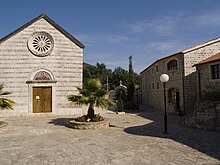

| Podmaine Monastery Манастир Подмаине | |
|---|---|
 | |
| Religion | |
| Affiliation | Serbian Orthodox Church |
| Ecclesiastical or organizational status | Metropolitanate of Montenegro and the Littoral |
| Location | |
| Location | Podmaine, Budva |
| State | Zeta (modern-day Montenegro) |
|
Shown within Montenegro | |
| Geographic coordinates | 42°17′52″N 18°50′40″E / 42.2979°N 18.8445°E / 42.2979; 18.8445 |
| Architecture | |
| Founder | Crnojević noble family |
| Completed | 15th century[1] |
| Website | |
| http://www.manastirpodmaine.rs/ | |
The Podmaine Monastery (Serbian: Манастир Подмаине, romanized: Manastir Podmaine) is a Serbian Orthodox monastery built in the 15th century by the Crnojević noble family in Podmaine near Budva, Zeta (modern day Montenegro).[1][2] The monastery has two churches, smaller and older church of Presentation of the Mother of God was built by Crnojević noble family in the 15th century while bigger church (of Dormition of the Mother of God) was built in 1747.
The name Podmaine (Pod-Maine) means "beneath Maine". Maine was a small tribe with territory below Lovćen, between Stanjevići Monastery and Budva.[3] The monastery was the gathering place of the tribe, who traditionally held meetings on the feast dayofSt. George.[4]
The exact year of establishment of the monastery is unknown. The church of Dormition of the Mother of God was built in the 15th century and reconstructed in 1630 while its larger church (Church of St. Petka) was built in 1747.[5]
Metropolitan Danilo I Petrović-Njegoš died in Podmaine Monastery in 1735. He was buried in the monastery but his remnants were later moved to Cetinje.[6][7] Dositej Obradović lived several months in the monastery when he visited Boka in 1764.[8]
In 1830 Petar II Petrović-Njegoš, based on the request of the emperor of Russia, sold Podmaine Monastery and Stanjevići Monastery together with their estates to the Austrian Empire.[9]
Njegoš wrote parts of his masterpiece The Mountain Wreath in Podmaine Monastery.[10]

Frescoes in the Church of St. Petka were painted by Rafail Dimitrijević from Risan in 1747 and Nicholaos Aspioti from Corfu.[11][12] The monastery was burned down in 1869.[13] In the 1979 earthquake the monastery was significantly damaged and in 2002 it was completely rebuilt and new frescoes were painted in the smaller church (dedicated to the Dormition of the Mother of God). According to some views one of the frescoes titled Sinful bishops and emperors (Serbian: Лажни епископи и цареви) presents a former Yugoslav leader Tito and heads of the uncanonical Montenegrin Orthodox Churchasdamned and handed over to devils who herd them down into hell in a modern version of the Last Judgment.[14]
The complex was made of the Smaller church dedicated to Uspenje Presvete Bogorodice and was built in XV century by Crnojevici.
МАНАСТИР ПОДМАИНЕ У сјевероисточном дијелу Будванског поља, с де- сне стране пута који води за
Говорећи о Маинама напоменуо је да су Маине — „као мала кнежина или племе под Ловћеном између манастира Стањевића и Будве"
Манастир ПОДМАИНЕ или ПОД- ОСТРОГ, близу Будве, такоЬе има две цркве: Успен>а Богородице и Св. Пет- ке. Не зна се када је манастир основан; мала црква ]е обновљена 1630. године. Данашн>у већу цркву подигао ]е 1747
У свом манастиру Подмаине владика је Данило и умро 11/22. јануара 1735. г. Ту је и сахрањен.15 Кад је Његош 12. октобра 1837. г.1в уступио Аустрији ма- настир Подмаине са свим његовим добрима за 17.000 форинти у сребру
...koji je kasnije prenesen na Cetinje i sahranjen na Orlovom kršu
У овоме манастиру провео је неколико мје- сеци Доситеј Обрадовић, кад је г. 1764 био дошао у Боку
U manastiru Podmaine nedaleko od Budve, gde je Njegoš svojevremeno pisao Slobodijadu i pojedine segmente Gorskog vijenca
У близини манастира Подострога налази се манастир Подмаине с црквом св. Петке, коју је живописао зограф Ра- фаил Димитријевић г. 1747.
The nearby monastery of Podmaine was burnt down in 1869, but the surviving church is decorated with wall paintings by Rafailo Dimitrijevid of Risan (1747) and has an iconostasis by Nicholaos Aspioti.
"Ипак, чини се да је најдаље отишао живописац у манастиру Подострог, у Маинама изнад Будве. На фресци сија петокрака са маршалске капе друга Тита, којег демон одвлачи у ватру пакла. Осим Броза, ту су и, по свему судећи, свештеници самозване Црногорске православне цркве. У углу стоји и опис: 'лажни епископи и цареви'.